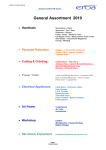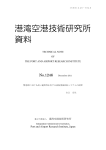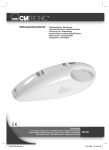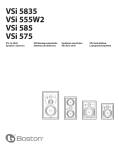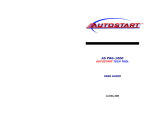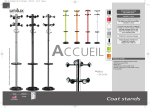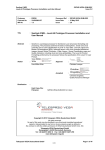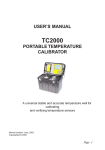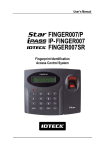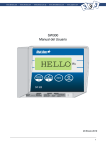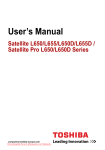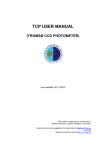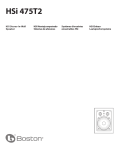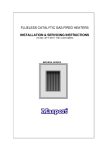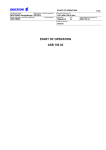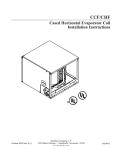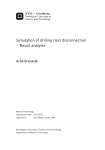Download PEI.FZA_QGEP_Anexo D
Transcript
Plano de Emergência Individual Bloco FZA-M-90 Bacia da Foz do Amazonas ANEXO D ANEXO D – DADOS DO SISTEMA DE TECNOLOGIA INOVADORA Rev.00 Junho/2015 Page/side 1 of/av 1 NOFI Document no. / Dokumentnr.: L650 - F - 500 NOFI Document name / Dokumentnavn: NOFI Current Buster® 6 Pat. DATASHEET (see also drawing L650-A-102) B A 02.01.12 20.05.11 Updated with weigt and storage volum Preliminary. For information only. Revision Revisjon Date (d,m,y) Dato (d,m,å) Issued for Utgitt for øw dn dn By Av Checked Sjekket Approved Godkjent TECHNICAL DATA Dimensions: Storage weight (dry): Storage volume on boom reel: Front Opening(Swath): Separator tank: Flotation/cross beams: All external fabric : Material buoyancy chambers: Mooring and lifting points: Retrieval line at the stern: Reflective markings: Documentation: Freeboard: Separator tank: Ø 1000/800mm, guide booms: Ø 800/600mm Length: 62,9m Width: 4,6m Maximum Depth during operation: Ca. 2,6m Total: 2017kg. Sweep and guide booms: 872 kg Separator: 1145 kg Min. 10m³ 34m Gross volume 65m³, Net ca. 35m³ oil. Separation system is based on gravity separation. In large spills the oil thickness will be min. 1m. 33 independent air chambers and 6 air filled cross beams with valve type MONSUN XII.2. Heavy Duty PU/PVC-coated polyester, 1150g/m², tensile strength 7400 N/50mm, tear strength min.1900 N. Airtight PU/PVC blend coated polyester, 1150g/m² 8 off, evenly distributed around the system. 4 fastening points, split link connection to the retrieval line. 50x200mm reflective pads distributed around the system. On the in and outside. Complete user documentation, L650-K-610 OPERATIONAL DATA Area of use: Oil types: Towing /operational speed: Debris collection system: Temporary Oil storage: Inflation: Deployment: Retrieval: Adjustments during operation: Skimmer Interface: Storage: Storage and operating temp.: Offshore and open coast up to Beaufort 5. Protected inlets, fjords, sounds and harbours in extreme weather up to wind Beaufort 7. Also any strong current exposed area with sufficient depth. All types from diesel to high viscosity oil, ca. 5 – 180000cPS. Effective collecting, concentrating and separating oil: Min. towing speed: 0,1-0,5 knots, Calm water: 5 knots, When towing directly against short period waves the max. speed gradually decrease when wave height increase. Prevents debris from entering the Pumping area. The integrated non return valve enables the separator tank to be used for temporary storage of recovered oil. HOLD for verification. By backpack blower or electric/hydraulic fan through Monsun XII.2 valves Deployment with guidebooms or separator tank first. An area with minimum width of 5m and length of 5m is recommended in front of the boom reel. Deployment time from reel ca. 25 minutes if two fans are available. The NCB6 can be retrieved with guidebooms or separator tank first. Retrieval time ca. 30 minutes. The system is designed for operation without any adjustments required even if the speed and oil types vary. Within the operational limits, the oil thickness in the separator is high with no current or vortex. Almost all types of skimmers and pumps may be used efficiently in the separator with low water content of recovered oil. On boomreel with shaft diameter of minimum 500mm. Turntable recommended for easier retrieval. -35 to +70°C (-13 to 158 °F) Subject to contractual terms to the contrary, this document and its content are the property of NOFI Tromsø AS and may not be reproduced or shown to any third party without our prior written approval. Dette dokumentet er NOFI Tromsø AS sin eiendom og skal ikke kopieres eller vises tredjeperson uten vår skriftlige forhåndsgodkjennelse Page/side 1 of/av 16 Document Name / Dokumentnavn: NOFI Current Bustery 6 Pat. User’s manual NOFI Document no. / Dokumentnr.: L650 - M - 640 A 02.04.12 Comments Revision Revisjon Date (d,m,y) Dato (d,m,å) Issued for Utgitt for By Av Checked Sjekket Approved Godkjent Subject to contractual terms to the contrary, this document and its content are the property of NOFI Tromsø AS and may not be reproduced or shown to any third party without our prior written approval. Om ikke annet er avtalt i kontraktsbetingelser er dette dokumentet NOFI Tromsø AS sin eiendom og skal ikke kopieres eller vises tredjeperson uten vår skriftlige forhåndsgodkjennelse. Doc. no./ Dok. nr. L650-M-640 Rev.: A Doc. name/Dok. navn: NOFI Current Bustery 6 Pat. Page/side 2 of/av 16 User’s Manual TABLE OF CONTENTS 0 GENERAL ............................................................................................................................................................... 3 1 SYSTEM DESCRIPTION ........................................................................................................................................ 3 General .............................................................................................................................................................. 3 NOFI Current Buster 6 ....................................................................................................................................... 4 Pat.Pend High speed Otter Guidebooms ................................................................................................................ 4 Sweep ................................................................................................................................................................ 4 Collector area .................................................................................................................................................... 4 Tapered Channel Skimming Device .................................................................................................................. 5 Separator and storage tank ............................................................................................................................... 5 Water Drainage Valves ...................................................................................................................................... 5 Towlines and retrieval line ................................................................................................................................. 5 CONSTRUCTION ....................................................................................................................................................... 6 Outer fabric ........................................................................................................................................................ 6 Air Chambers ..................................................................................................................................................... 6 Crossbeams ...................................................................................................................................................... 7 Debris collection and wave dampening system ................................................................................................ 7 Wave dampening feature and splash over protection in the stern .................................................................... 7 Transportation and decon detachment and assembly point (TDDAP) .............................................................. 8 Oil stopping Device ............................................................................................................................................ 8 Tie off loops ....................................................................................................................................................... 8 Retrieval bridle ................................................................................................................................................... 8 Valves ................................................................................................................................................................ 8 Reflective areas ................................................................................................................................................. 8 Highlighted areas ............................................................................................................................................... 9 Pump area ......................................................................................................................................................... 9 2 STORAGE, DEPLOYMENT AND RETRIEVAL ...................................................................................................10 Storage ...........................................................................................................................................................10 Deployment .....................................................................................................................................................10 Inflation ...........................................................................................................................................................10 RETRIEVAL ...........................................................................................................................................................11 Retrieving with Guidebooms first ....................................................................................................................11 Retrieving with Separator tank first .................................................................................................................11 3 OPERATION ........................................................................................................................................................12 Two boats towing, one boat pumping .............................................................................................................12 Tow forces ......................................................................................................................................................12 Filling the Separator tank ................................................................................................................................12 Adjustment ......................................................................................................................................................13 Maximum towing speed ..................................................................................................................................13 Towing backwards is not recommended .........................................................................................................13 Transportation speed ......................................................................................................................................13 Type of oil .......................................................................................................................................................13 Re-inflation of air chambers ............................................................................................................................13 Pumps and skimmers .....................................................................................................................................14 Pumping and offloading recovered oil .............................................................................................................14 Turning the Current Buster system .................................................................................................................15 Removal of debris ...........................................................................................................................................15 Towing configuration .......................................................................................................................................16 Small Spills .....................................................................................................................................................16 Subject to contractual terms to the contrary, this document and its content are the property of NOFI Tromsø AS and may not be reproduced or shown to any third party without our prior written approval. Om ikke annet er avtalt i kontraktsbetingelser er dette dokumentet NOFI Tromsø AS sin eiendom og skal ikke kopieres eller vises tredjeperson uten vår skriftlige forhåndsgodkjennelse. Rev.: A Doc. no./ Dok. nr. L650-M-640 Doc. name/Dok. navn: NOFI Current Bustery 6 Pat. Page/side 3 of/av 16 User’s Manual 0 GENERAL Pat. This manual describes the use of the NOFI Current Bustery 6 . The NOFI Current Buster 6 (NCB6) is the latest product based on the CURRENT BUSTER TECHNOLOGY. Some of the pictures in this manual show other NOFI Current Buster systems. All fabrics are vulnerable to damage when dragged over sharp edges, rough concrete and asphalt etc. Such surfaces and sharp edges must be covered with tarpaulin or similar. After use in oil the equipment should be cleaned as soon as possible, see General Cleaning Procedure for oil booms and PVC/PU fabrics, doc. no. F000-N-680, and NOFI Current Buster Cleaning Guide, doc. no. L600-N-682. Pat. NOTE: The NOFI Current Bustery 6 is a contingency boom and is not designed for permanent anchoring. During outdoor storage the equipment must be covered with a tarpaulin to avoid damage from sunlight. If stored in a closed container etc. proper ventilation should be provided to prevent growth of micro-organisms. SAFETY : Any boom handling and especially high speed operations involve heavy forces and impose a safety ri sk. In order to avoid personnel injuries, sound seamanship should be practised in all operations. Local sa fety regulations and practice must be followed. 1 SYSTEM DESCRIPTION General Pat. The NOFI Current Bustery 6 is designed to collect, separate and contain oil at speeds ranging from 0,5 up to 5 knots in reasonable weather conditions. Results from testing the NOFI Current Buster 4, in OHMSETT test tank, indicate that the system will normally contain 65% to 98% of the oil, depending on speed, type of oil and wave conditions. The system is generally delivered with towlines and retrieval line. Guidebooms and sweep are integrated in the NOFI Current Buster 6 system. For more information, see Data Sheet, doc. no. L650-F-500. Fig. 1: NOFI Current Bustery 6Pat. Subject to contractual terms to the contrary, this document and its content are the property of NOFI Tromsø AS and may not be reproduced or shown to any third party without our prior written approval. Om ikke annet er avtalt i kontraktsbetingelser er dette dokumentet NOFI Tromsø AS sin eiendom og skal ikke kopieres eller vises tredjeperson uten vår skriftlige forhåndsgodkjennelse. Rev.: A Doc. no./ Dok. nr. L650-M-640 Doc. name/Dok. navn: NOFI Current Bustery 6 Pat. Page/side 4 of/av 16 User’s Manual NOFI Current Buster 6 The NOFI Current Buster 6 system is supplied as a complete unit, and consists of 5 main parts: Pat.Pend 1. High speed Otter guideboom 2. Sweep 3. Collector area 4. Tapered channel skimming device 5. Separator and storage tank See drawing no. L650-A-104 for details and dimensions. Fig. 2: NOFI Current Buster 6 at ca. 4 knot towing speed Pat.Pend High speed Otter Guidebooms The integrated Otter guidebooms are optimised to give a larger front opening compared to a conventional oil boom. Fig. 3: Integrated high speed OtterPat.Pend guideboom Sweep ® The integrated Sweep is based on NOFI VEE-SWEEP technology, with open apex. Fig. 4: Integrated sweep Collector area The collector area is located at the stern part of the “V”-shaped sweep. The main purpose of the collector area is to create optimal flow conditions into the tapered channel skimming device. Fig. 5: Position of the collector area Subject to contractual terms to the contrary, this document and its content are the property of NOFI Tromsø AS and may not be reproduced or shown to any third party without our prior written approval. Om ikke annet er avtalt i kontraktsbetingelser er dette dokumentet NOFI Tromsø AS sin eiendom og skal ikke kopieres eller vises tredjeperson uten vår skriftlige forhåndsgodkjennelse. Rev.: A Doc. no./ Dok. nr. L650-M-640 Doc. name/Dok. navn: NOFI Current Bustery 6 Pat. Page/side 5 of/av 16 User’s Manual Tapered Channel Skimming Device The main purpose of the Tapered Channel Skimming Device is to lift the upper layer of the water containing the oil into the separator, while draining most of the surplus water under the system. Fig. 6: Position of the tapered channel skimming device Separator and storage tank The oil and water mixture entering the separator is separated by gravity separation (settling). The large volume of the separator ensures sufficient separation time so the oil is effectively separated from the seawater. Surplus water is drained through valves in the bottom of the separator. During operation, even at high speeds, the oil is calm in a thick layer inside the separator, and consequently optimal pumping conditions are achieved. Fig. 7: Position of the separator Water Drainage Valves The drainage valves are distributed in the bottom of the separator tank. Overpressure in the separator tank causes the valves to open and let out excess water. Towlines and retrieval line Normally two 50 m towlines and two 4 m tow bridles are supplied with the system. Tow bridle and towline can be disconnected. Tow Bridle Towline Fig.8: Towline and tow bridle A retrieval line is connected to the stern of the NOFI Current Buster 6. The line may be connected or disconnected near the stern of the NOFI Current Buster 6 with a quick link (G-Hook). 20mm retieval line. Min break load 6600kg G-hook quick connection Float Retrieval bridle Fig.9: Retrieval line Subject to contractual terms to the contrary, this document and its content are the property of NOFI Tromsø AS and may not be reproduced or shown to any third party without our prior written approval. Om ikke annet er avtalt i kontraktsbetingelser er dette dokumentet NOFI Tromsø AS sin eiendom og skal ikke kopieres eller vises tredjeperson uten vår skriftlige forhåndsgodkjennelse. Rev.: A Doc. no./ Dok. nr. L650-M-640 Doc. name/Dok. navn: NOFI Current Bustery 6 Pat. Page/side 6 of/av 16 User’s Manual Construction The NOFI Current Buster 6 is made as one unit except the Crossbeams (6 off) and may be divided in two for transportation or decontamination purposes. The system consists of an outer fabric (Jacket) protecting the air chambers. Outer fabric The outer fabric is folded over the air chambers and connected on top by plastic eyelets and cleats locked by a plastic-covered rope, which may be disconnected during cleaning when the system is contaminated. Outer fabric (Jacket) Air chamber Fig. 10: Outer fabric enclosing the air chambers All loadbearing functions (mooring points, fastening points for the transverse bladders etc) are handled by the outer fabric NOTE: If the cleats are deformed by pressure or heat the original shape may be restored with the help of a hot air gun. Air Chambers The NOFI Current Buster 6 has two air chamber systems. There is one in the Guide booms and one in the Separator tank. The air chambers in the Guide booms are 18 individual chambers whereas the air chambers in the separator area are connected to each other forming a frame work, called the Flotation frame. Flotation frame Individual air chambers Connection between air chambers Crossbeams The air filled Crossbeams add rigidity to the construction. In addition the Crossbeams located at the waterline in the separator have a wave dampening effect, reducing the waves coming into the separator. The Crossbeams may be removed for cleaning etc. and are correctly positioned by number codes on the Crossbeams that correspond with the code on the outer fabric. Note that the fastening straps on Crossbeam no. 1 and 2 are crossed as shown in the picture (see Fig. 11) Subject to contractual terms to the contrary, this document and its content are the property of NOFI Tromsø AS and may not be reproduced or shown to any third party without our prior written approval. Om ikke annet er avtalt i kontraktsbetingelser er dette dokumentet NOFI Tromsø AS sin eiendom og skal ikke kopieres eller vises tredjeperson uten vår skriftlige forhåndsgodkjennelse. Rev.: A Doc. no./ Dok. nr. L650-M-640 Doc. name/Dok. navn: NOFI Current Bustery 6 Pat. 6 5 4 3 2 1 Page/side 7 of/av 16 User’s Manual Fig. 11: Crossbeams, 6 off Fig. 12: Crossbeams with number coding. The crossed fastening straps only applies to Crossbeam 1 and 2. Debris collection and wave dampening system In connection with crossbeam no. 3 and no. 4 there are curtains that have the purpose to prevent debris from entering the Pump area. The curtains also act as a wave dampening system that reduces internal movement of oil and water content in the Separator tank. Wave dampening feature and splash over protection in the stern The purpose of the perforated fabric in the stern of the Separator and storage tank, see fig. 13, is to reduce splash over and reduce wave activity in rough weather conditions and in waves. The device also adds rigidity to the system. Fig. 13: Splash over protection/wave dampening system in the stern. Subject to contractual terms to the contrary, this document and its content are the property of NOFI Tromsø AS and may not be reproduced or shown to any third party without our prior written approval. Om ikke annet er avtalt i kontraktsbetingelser er dette dokumentet NOFI Tromsø AS sin eiendom og skal ikke kopieres eller vises tredjeperson uten vår skriftlige forhåndsgodkjennelse. Rev.: A Doc. no./ Dok. nr. L650-M-640 Doc. name/Dok. navn: NOFI Current Bustery 6 Pat. Page/side 8 of/av 16 User’s Manual Transportation and decon detachment and assembly point (TDDAP) The connection between the Buster Separator Tank and the integrated sweep and guide boom is a Transportation and decon detachment and assembly point (TDDAP). This includes a connection of the collector area net bottom section to the collector area skirt. Fig. 14: TDDAP Oil stopping Device This device is positioned at the end of the tapered channel towards the stern. During oil collection and operation the device will lay down in open position allowing oil to enter the separator tank. If the NCB6 system for any reason has to stop the device will go into closed position preventing the collected oil to escape. Tie off loops Nine tie off loops made in heavy duty webbing and abrasion reinforced fire hose are distributed along the entire NOFI Current Buster 6, see fig. 15. Loop 9 Loop 6 Loop 7 Loop 8 Loop 5 Loop 2 Loop 4 Loop 3 Loop 1 Fig. 15: Tie off loops The tie off loops indicated on Fig.15 are intended for heavy duty use e.g. towing of other devices, lifting etc. NOTE: Other potential tie off loops or similar must not be used for any fastening, including the closing wire on top of the freeboard or line on the valve lid. The only exception is fastening of small objects such as radar reflectors or marking lights. Retrieval bridle At the stern of the separator there is a retrieval bridle made of heavy duty webbing and rope. The bridle may be temporarily dropped into the separator if there is any chance of the bridle interfering with propellers on vessels located alongside. Valves The air chambers are equipped with valves of type Monsun XII.2 for filling and evacuation of air. All air chambers including the cross beams are equipped with 2 off valves, one in each end. For contamination protection the valve has a screw cap that is secured to the valve with a cord. Reflective areas Reflective areas are situated under each valve and opposite area on the inside on the system see, fig. 16. Fig. 16: Reflective area Subject to contractual terms to the contrary, this document and its content are the property of NOFI Tromsø AS and may not be reproduced or shown to any third party without our prior written approval. Om ikke annet er avtalt i kontraktsbetingelser er dette dokumentet NOFI Tromsø AS sin eiendom og skal ikke kopieres eller vises tredjeperson uten vår skriftlige forhåndsgodkjennelse. Rev.: A Doc. no./ Dok. nr. L650-M-640 Doc. name/Dok. navn: NOFI Current Bustery 6 Pat. Page/side 9 of/av 16 User’s Manual Highlighted areas The NCB6 systems have three areas that are highlighted with text. This is information for utility vessels and about areas on the boom that can affect their operation. The front ends of the Guide booms has text both on the in- and on outside. Outside text states system Starboard and Portside. The inside text, Front rope, states that there is a rope connected between Port and Starboard guide boom. The start of the net section is marked with text and a directional arrow. Fig. 17: Starboard Fig. 19: Net section Fig. 18: Front rope Pump area The dedicated area 3 x 3 m set of for pumping and skimming is Orange in contrast to the rest of the system which is Yellow. “Pump Area” is specified in black letters on the orange areas. Fig. 20: 3 x 3 m Pump area in the Separator Subject to contractual terms to the contrary, this document and its content are the property of NOFI Tromsø AS and may not be reproduced or shown to any third party without our prior written approval. Om ikke annet er avtalt i kontraktsbetingelser er dette dokumentet NOFI Tromsø AS sin eiendom og skal ikke kopieres eller vises tredjeperson uten vår skriftlige forhåndsgodkjennelse. Rev.: A Doc. no./ Dok. nr. L650-M-640 Doc. name/Dok. navn: NOFI Current Bustery 6 Pat. Page/side 10 of/av 16 User’s Manual 2STORAGE, DEPLOYMENT AND RETRIEVAL Storage The NOFI Current Buster 6 system can be stored in a custom made storage container, on a pallet or on a boom reel. The inner diameter of the reel should be at least 500 mm in order to avoid damage to the valves. Fig. 21: NOFI Current Buster 6 stored on a 10m 3 boom reel Deployment The NOFI Current Buster 6 is designed for deployment with guidebooms or separator tank first. An area with minimum width of 5m and length of 5m is recommended in front of the boom reel. Deployment time from reel is approx. 25 minutes if two fans are available. The integrated Sweep net is weighted and will sink. When deploying in shallow water the net may snag on the bottom. In such unfavourable conditions a rope may be tied around the sweep arms and the netting to prevent the net from sinking. NOTE: This rope must be cut or removed prior to operation. Inflation Inflation is normally done by a backpack type fan. Electric and hydraulic fans may also be used. To save time, two fans are recommended, one on each side, during deployment. The air chamber is pressurised to maximum level of a backpack fan, approximately 100 mbar. CAUTION: The use pressure air for inflation is not recommended due to danger for overpressure and rupture causing personal injury. If for any reason pressure air without pressure gauge is used, the following guidelines may be followed for correct pressure: At 50-100 mbar a normal person may press a knee 510 cm down or a thumb 2-4 cm down in the air chamber, see pictures. 5 - 10 cm 2 - 4 cm Fig. 22: Testing the overpressure by depressing the air chamber with a knee (left) or a thumb (right). The Monsun XII.2 valves have an open and a closed position. W hen the valve seat (plate) is pressed down and turned to the right the valve is locked in open position (as is done during retrieval). When turning to the left the valve is closed. It is still possible to perform inflation with the valve in closed position, since the air pressure presses down the spring activated valve seat, thus letting air in. Subject to contractual terms to the contrary, this document and its content are the property of NOFI Tromsø AS and may not be reproduced or shown to any third party without our prior written approval. Om ikke annet er avtalt i kontraktsbetingelser er dette dokumentet NOFI Tromsø AS sin eiendom og skal ikke kopieres eller vises tredjeperson uten vår skriftlige forhåndsgodkjennelse. Rev.: A Doc. no./ Dok. nr. L650-M-640 Doc. name/Dok. navn: NOFI Current Bustery 6 Pat. Page/side 11 of/av 16 User’s Manual SAFETY: If the screw cap isn’t attached oil may enter the valve and oil may splash into your face and eyes the next time the valve is opened. Screw cap Valve seat Fig. 23: Monsun XII.2 valve (left) with screw cap (right) shown in open position. The valve seat (plate) in the middle of the valve has been pressed down and turned right. Valve In orde r to attain sufficient pressure in the air chambers, inflation must be performed with the valve plate in closed position. Let the fan run at full speed until the inflation hose nozzle has been pulled out of the valve. The spring-activated valve closes automatically and no air pressure is lost during opening and closing of the valves. All air chambers have two valves. The purpose is to make it easy to inflate/deflate the NOFI Current Buster 6 where the space is limited. Prior to inflation make sure that the opposite valve is closed. Corresponding valves have the same colour coding. Retrieval The Current Buster 6 system is designed to be retrieved in both directions with separator or guidebooms first. Retrieving with Guidebooms first Retrieving with the Guidebooms first has not been tested thoroughly and should be performed with caution. Each user should develop their own strategy for this operation. IMPORTANT NOTE: When retrieving the NOFI Current Buster 6 with guidebooms first it takes time before the water in the separator is drained out through the Drainage valves. This must be done gradually, lifting inch by inch, without applying too much force. Retrieving with Separator tank first A retrieval line, 50m, is connected to the retrieval bridle by a G-Hook (splitlink) connection (see Fig. 24). The line has a minimum breaking load of 6600kg and is the weak-link during retrieval. Retrieval time ca. 30 minutes. 20mm retieval line. Min break load 6600kg G-hook quick connection Float Retrieval bridle Fig. 24: Retrieval line with G-hooks IMPORTANT NOTE: When retrieving the NOFI Current Buster 6 it takes some time before the separator is emptied since the water has to flow over the oil stopping device and through the tapered channel and the narrow water outlet in the separator. This must be done gradually, lifting inch by inch, without applying too much force. In unfavourable conditions water pockets may be formed, requiring manual intervention. If the system is retrieved to a boom reel, it must be wound up firmly. A vessel or a vehicle may assist in maintaining tension in the system while it is being retrieved. When winding up the towlines, one should make sure that the towlines do not get stuck in between the boom reel’s sidewalls and the boom system itself, due to risk of jamming the towlines. Subject to contractual terms to the contrary, this document and its content are the property of NOFI Tromsø AS and may not be reproduced or shown to any third party without our prior written approval. Om ikke annet er avtalt i kontraktsbetingelser er dette dokumentet NOFI Tromsø AS sin eiendom og skal ikke kopieres eller vises tredjeperson uten vår skriftlige forhåndsgodkjennelse. Rev.: A Doc. no./ Dok. nr. L650-M-640 Doc. name/Dok. navn: NOFI Current Bustery 6 Pat. Page/side 12 of/av 16 User’s Manual 3 OPERATION The NOFI Current Buster 6 system is a rather new concept and this manual does not describe optimal operation with all types of vessels/equipment or all modes of operation. Each user should develop their own standard operational procedure based on their own needs. Single vessel operation NOFI Current Buster 6 has been tested with a single boat and BoomVane. The test was performed with a standard BoomVane and gave a sweep width of ca.18m. Type and size of towboat The towboats should be of a type that has good directional stability and in other ways are suitable to tow objects. Two boats towing, one boat pumping Fig.s 25 and 26 show the system being towed by the help of 2 towboats. Fig. 25: Two boats tow the system. A skimming vessel is moored alongside the separator while towing. Fig. 26: NOFI Current Buster 6 in a two boat configuration during testing in Tromsø. Tow forces Measurements performed during testing has indicated approximate tow forces: At 3 knots the tow force was measured to approx.1,8 tons per vessel, and at 5 knots about 3 tons per vessel. The values apply for straightforward movement with even speed in calm sea. In case of sudden changes in speed or direction, and in choppy sea, larger tow forces must be expected. Filling the Separator tank When the towing starts, the separator will gradually fill with water. An initiate speed of ca. 2,5 - 5 knots is recommended in order to fill up the separator. The filling process takes approx. 10-15 minutes depending on towing speed. During this process the separator bottom may appear unstable but the system will still collect oil. If the towing stops, ballast in the separator will impede the separator bottom from floating up. However, some water may escape, and when the towing begins again it will take a few minutes to reach the normal filling level. Subject to contractual terms to the contrary, this document and its content are the property of NOFI Tromsø AS and may not be reproduced or shown to any third party without our prior written approval. Om ikke annet er avtalt i kontraktsbetingelser er dette dokumentet NOFI Tromsø AS sin eiendom og skal ikke kopieres eller vises tredjeperson uten vår skriftlige forhåndsgodkjennelse. Rev.: A Doc. no./ Dok. nr. L650-M-640 Doc. name/Dok. navn: NOFI Current Bustery 6 Pat. Page/side 13 of/av 16 User’s Manual Adjustment Even if speed through the water and oil type vary no adjustments of the system are required. Maximum towing speed The maximum towing speed is determined in two ways: 1) The maximum oil collecting speed is 5 knots through water. Operation at higher speed is not recommended. Note that in current exposed areas a GPS reading will give wrong speed reading against water. 2) When towing directly against short-period waves the speed should be limited to 3 knots. W hen splash over occurs in the stern the speed must be further reduced as contained oil is lost. Normally higher speeds may be used when towing with the waves or at 90 degrees to the wave direction, compared to directly into the waves, see Fig. 27. Waves and wind Reduced speed against waves High speed High speed High speed Fig. 27: Towing speed in relation to wind/waves Towing backwards is not recommended CAUTION: Towing the system backwards (except during retrieval at very low speed) is not recommended, as the system is not designed for this and will be damaged. Transportation speed If the system needs to be transported rapidly from one location to another, actions should be made to decrease the front opening of the system in order to reduce the amount of water entering the system. This may be done by transferring both towlines to one vessel. Speed through water should still be limited to 6 knots. Type of oil The available information from tests conducted with oil indicates that the system can handle most types of oil from low to high viscosities, including diesel oil. Some reports indicate that the system may even be efficient in collecting blue shine. Re-inflation of air chambers If there are significant temperature variations (between night and day) or long operating periods the air chambers may require re-inflation if they deflate or deform. This may be done with portable fans. Subject to contractual terms to the contrary, this document and its content are the property of NOFI Tromsø AS and may not be reproduced or shown to any third party without our prior written approval. Om ikke annet er avtalt i kontraktsbetingelser er dette dokumentet NOFI Tromsø AS sin eiendom og skal ikke kopieres eller vises tredjeperson uten vår skriftlige forhåndsgodkjennelse. Rev.: A Doc. no./ Dok. nr. L650-M-640 Doc. name/Dok. navn: NOFI Current Bustery 6 Pat. Page/side 14 of/av 16 User’s Manual Pumps and skimmers The NCB6 system is capable of accumulating up to 1m of oil in the Separator. This should be taken in to consideration when choosing what kind of offloading equipment to be used. Several types of pumps and skimmers may be used for offloading the separator. The pump’s or skimmer’s outer surface must be free from sharp edges or rotating parts, which may damage the fabric. Pay attention to the pump and hoses so that no abrasion damage occur e.g. on top of the freeboard. If necessary attach some abrasion protection, tarpaulin etc. Fig. 28: A skimmer in the separator (Image of NOFI Current Buster 2) Fig. 29: Rope mop skimmer operating in the separator(Image of NOFI Current Buster 2) Pumping and offloading recovered oil The pumping vessel can be moored alongside the separator. In order to avoid damage to the system, the pumping vessel should be of a reasonable size compared to the NOFI Current Buster 6, and not have sharp edges or similar facing the system. Connected to towline Pumping vessel Fig. 30: Pumping vessel moored alongside the separator with mooring lines indicated. Fig. 31: Mooring line from the bow of the pumping vessel to the connection point between the sweep and the towline. (Image of NOFI Current Buster 4) Depending on available vessels and utility equipment there are several possible methods and strategies for pumping of the Current Buster 6. SAFETY: Make sure that the pumping vessel does not drift off during high-speed operation leading to the skimmer snagging in the separator. Subject to contractual terms to the contrary, this document and its content are the property of NOFI Tromsø AS and may not be reproduced or shown to any third party without our prior written approval. Om ikke annet er avtalt i kontraktsbetingelser er dette dokumentet NOFI Tromsø AS sin eiendom og skal ikke kopieres eller vises tredjeperson uten vår skriftlige forhåndsgodkjennelse. Rev.: A Doc. no./ Dok. nr. L650-M-640 Doc. name/Dok. navn: NOFI Current Bustery 6 Pat. Page/side 15 of/av 16 User’s Manual Fig.32: Excavator with pump offloading a NOFI Current Buster 8 during the Macondo spill in 2010. Turning the NOFI Current Buster system If the two towboats are well coordinated, it is a simple task to turn the whole boom system. This can be done with the pumping vessel moored alongside the separator. Fig. 33: Turning the system at high towing speed (Image of NOFI Current Buster 4) Removal of debris Logs, debris and sharp objects may enter the system and cause serious damage. If this occurs, stop the operation and remove the debris. Floating seaweed, kelp etc. may after a time clog the bottom net in the collector area, create an obstruction in the tapered channel tunnel or clog the outlet of the separator. Fig. 34: Tapered channel clogged by hawser Subject to contractual terms to the contrary, this document and its content are the property of NOFI Tromsø AS and may not be reproduced or shown to any third party without our prior written approval. Om ikke annet er avtalt i kontraktsbetingelser er dette dokumentet NOFI Tromsø AS sin eiendom og skal ikke kopieres eller vises tredjeperson uten vår skriftlige forhåndsgodkjennelse. Rev.: A Doc. no./ Dok. nr. L650-M-640 Doc. name/Dok. navn: NOFI Current Bustery 6 Pat. Page/side 16 of/av 16 User’s Manual If the clogging reduces the performance to an unacceptable level the foreign objects must be removed while the towing is stopped. Towing configuration The following information should be handed over to the towboat captains prior to towing: In order to maintain the correct towing formation when operating the NOFI Current Buster 6 the following rules should be followed: 1) One towboat should lead and the other should follow and make necessary adjustments. Still both the towboats are responsible for keeping the system in a good formation. Agree on who is the leader boat, draw lots if necessary. 2) The towlines should have equal lengths and be moored as low as possible on the towboats. 3) Both towboats should continuously monitor the boom. 4) Start towing at 2,5 knots, the distance between the towboats small, e.g. 15-20 m. 5) The towboats should preferably move more or less in parallel. 6) The towboats should practice on changes in speed and course. 7) Gradually increase the distance between the towboats until correct formation is achieved, see Fig. 35. 8) If there are continuous problems with misshape of the boom the boats may move closer. 9) It is normally easier to keep the configuration of the system at a speed above 2 knots. Move forwar d Consider moving closer together Slow down Front rope Correct configuration of front rope (rope not fully stretched out) Observe continuously for any misshape of the boom in these areas and correct immediately Misshape on Guideboom FAULT THAT MUST BE CORRECTED Misshape on Sweep FAULT THAT MUST BE CORRECTED Fig. 35: Correct positioning of towboats. Fig. 36: Incorrect positioning of towboats causing misshape on guide boom and sweep. Small Spills If the oil spill is small, i.e. less than the storage capacity of the separator (approx. 30-40 tonnes), two boats may tow the system and the oil may be discharged at the end of the clean-up operation. Alternatively, a pumping vessel may empty the separator as needed. Subject to contractual terms to the contrary, this document and its content are the property of NOFI Tromsø AS and may not be reproduced or shown to any third party without our prior written approval. Om ikke annet er avtalt i kontraktsbetingelser er dette dokumentet NOFI Tromsø AS sin eiendom og skal ikke kopieres eller vises tredjeperson uten vår skriftlige forhåndsgodkjennelse.


























